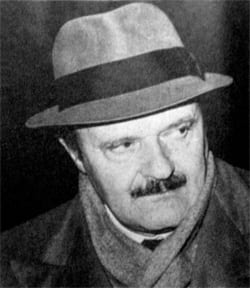5 Eerie Deaths That Have Unsatisfying Official Explanations

Most conspiracy theories are nuts. But nuts happen to be a major source of magnesium, which is essential for nerve function, so if they want to keep us quiet, magnesium is exactly what they don't want us to eat. So anyway, before we become totally incapacitated by visions of delicious filberts and almonds and macadamias and walnuts and cashews, here's this article about mysterious deaths that are weird enough to make you do a double take.
Did Enemies Kill This Rolling Stone Reporter By Hacking His Car?
Warning: The official answer to the above question, based on the consensus of many who looked at the story, is no. But we think you're still going to find this eerie, and if this reporter wasn't assassinated, that just raises further questions.

Michael Hastings wrote for such publications as Rolling Stone, GQ, and BuzzFeed News. He won awards, he covered the Iraq War, and he reported extensively on how the Obama administration spied on Americans. One of his profiles led to David Patraeus' predecessor in Afghanistan being removed from duty. We're saying he was a legit journalist, not the sort of person who you'd generally dismiss as a paranoid nutcase. So in 2013, when he told a friend the FBI was investigating him, that he was chasing a big story, and he was now afraid to use his own car, she took him seriously.
She did not, however, lend him a replacement vehicle like he asked. Her Volvo had been giving trouble and was in no shape for whatever desperate journey Hastings planned. So Hastings, who'd already emailed colleagues to say he'd be going off the grid to dodge the investigators tailing him, got into his own Mercedes to flee Los Angeles in the middle of the night. The car suddenly accelerated to its maximum speed and slammed into a palm tree, killing him. According to the one witness who saw the entire accident, the car started sparking and caught firebefore it collided into the tree, and it looked like the driver lost control while it was at top speed.

Hearing that, you might almost say it's like the car was being controlled by someone else. Which would be absolute crazy talk a few decades ago but may not be now. Cars have computers. The news dug up one counterterrorism and cyberwarfare expert who's advised multiple presidents and asked him about the crash, and he said yeah, that's what a cyberattack would look like. Governments like the US likely have the tech to control cars, he said, and if they pull something like this, they'd likely get away with it. As for what Hastings said about the FBI investigating him, the agency quickly put out a statement saying they'd done nothing of the kind. Then, pressed by reporters, they revised their statement to clarify that they'd lied and actually they had totally been investigating Hastings.
On the other hand, no one's been able to back up the theory that he was assassinated, and Hastings' own family now dismisses it. He died at exactly 4:20 AM after an evening of smoking weed (which he'd possibly been taking regularly to self-medicate for PTSD), and there were traces of other drugs in his system, Adderall or perhaps even meth. Did Hastings, like one friend suggests, accidentally crash while confusedly fleeing imagined pursuers?
Russia's Always Been Vague About How Yuri Gagarin Died
Buzz Aldrin is still alive today at the age of 90. William Thornton, who flew on Challenger, is still alive at 91, and quite a few astronauts are now in their eighties, like Harrison Schmitt, Ken Mattingly, and Bill Anders. If you travel to space and make it back in one piece, it seems you have every chance of making it into old age, because astronauts are naturally supermen and because of the health benefits of having sex four times daily for decades. A shame then that the first person to go to space died just a few years later, not living long enough to even see man reach the Moon.

Yuri Gagarin went to space just once. He flew on Vostok 1 in 1961, and he was all set to fly backup on Soyuz 1, but when that mission ended horribly and burned the cosmonaut inside to a crisp, Moscow figured they better put VIP Yuri off space duty permanently. Still a fan of flying, Gagarin joined the Air Force Engineering Academy, good-naturedly accepting the demotion from spacecraft to aircraft. Within weeks of graduating, he crashed a plane and died.
Official reports said he likely swerved to avoid a bird or weather balloon. But in the conspiracy community, "weather balloon" is government shorthand for "yeah, this is bullshit, and we know more, but we're not telling," and head of state Leonid Brezhnev soon closed the investigation and labeled its results top secret. So what were the Soviets covering up? Some suggested Gagarin flew drunk that day, and the nation buried this info to preserve their national hero's legacy. Or maybe Brezhnev didn't like Gagarin being a hero, saw a threat in this one man's massive popularity, and so had him killed. This would tie perfectly with the rumor that Gagarin once threw a drink in Brezhnev's face, blaming him for the Soyuz 1 disaster.
We're not going to endorse those theories. But we are going to tell you about what Alexei Leonov told the world 45 years later. Leonov had been a cosmonaut alongside Gagarin, was at the military base where Gagarin crashed, and participated in the investigation. It wasn't till 2013 that he came forward and said that a large supersonic jet flew into Gagarin's airspace that day, making him lose control and crash. So, that would mean the military was to blame for the death, and the nation had good reason to cover that up. But despite that testimony, Gagarin's cause of death remains unchanged, and the Kremlin refuse to reopen the investigation.
It's disappointing that we should be forever unclear on circumstances surrounding the death of the first man in space. Assuming, that is, Gagarin was the first man in space. And that Moscow didn't send a bunch of others on failed flights before him and then just hid all their corpses ...
A Flood That Killed Dozens In Britain May Have Been Due To Secret Government Experiments
Lynmouth is a little English village, with a population of about 2,000. Nothing much has ever happened there, other than (we suppose) the occasional murder at the vicarage solved by an old lady or, for real thrills, the annual flower show. Except for one time in 1952 when 10 inches of rain fell in a single 24-hour period.
Some of this footage is silent because the sound all washed away.
Early on, a spot outside town called Dry Bridges washed away, and residents smiled politely as this was just Mother Nature expressing typical sardonic British humor. Then the rain became so strong it hurt your face as it fell. It dropped 90 million tons of water, enough to supply the town for a century. The river rose 60 feet. The storm destroyed 100 buildings, leaving hundreds of townsfolk homeless. 35 people died, some of their bodies swept away and never to be found, while one woman's body had to be identified by a wart on her back because the storm had ripped off her head and all her limbs.
There's a meteorological explanation behind the storm, stuff about pressure and cold fronts. So, if we were to claim that government experiments may have also contributed, we'd sound like that twitchy guy on the corner whose only friends are birds. While countries have shaky technology to seed clouds to make it rain, the UK officially didn't try anything like this before 1955. Or so the public thought. But then investigators dug in half a century later and discovered the UK totally did try something like that, in a secret operation called Project Cumulus between 1949 and 1952. And a Cumulus pilot had been experimentally seeding the clouds in the area just days before the flood.

The government still denies any connection between the project and the flood, and plenty of people who know all the facts remain skeptical that the government could have had any effect even if they'd wanted to. But if everything was above board, you have to wonder why they killed Cumulus right after the flood, and why classified documents explaining exactly what they did and when have gone "missing." You also might wonder why Britain would ever bother with studying cloud seeding, since it doesn't rain enough isn't exactly a common complaint among tourists. Don't worry, though, they had a perfectly good reason -- they wanted to create a storm big to fight enemy troops, and to increase the fallout from nuclear bombs.
This Army "Suicide" Sounds An Awful Lot Like A Cover-Up
On July 17, 2005, Private First Class LaVena Johnson called her parents from where she was stationed in Balad, Iraq. She had news, the good kind -- she was going to be coming home sooner than expected, and even besides this, she sounded her usual cheery self. Two days later, a soldier arrived at her parents' home to deliver some news that was definitely not the good kind: LaVena had died from a self-inflicted gunshot wound. They couldn't believe it. According to the military today, the Johnsons' skepticism about their daughter's official cause of death is just denial from parents in mourning.
But the Johnsons went a little further in their disbelief then sitting quietly and muttering, "This can't be happening." The spent years digging up the autopsy details and details from the secret investigation, which turned up all kinds of strange facts. Like that 5-foot-1 LaVena had managed to pull the trigger of a giant M16 rifle while its barrel was in her mouth, which sounded unlikely. Or that the Army sketch of the crime scene showed that her cot stood between that rifle and her body ... wait, what?! If that's true, it wasn't a suicide, right, end of story?
Photos of the body made things look even more suspicious. There's no reason a gunshot to the roof of the mouth should loosen someone's teeth, or split their lip, or break their nose. That would instead seem to indicate some kind of unconnected physical trauma prior to death. And what about the massive burns on the body? The Army offered no explanation for those, and the way the father describes it, the burns were concentrated on the groin as though to destroy evidence.
You see where all this is going. The Johnsons' theory is that LaVena was raped ( very common in the military), someone killed her and tried to cover it up, and though the military figured out what had happened, they decided the cover-up suited them as much as it did the murderer. It makes so much sense that this really seems to shoot past being an intriguing conspiracy theory and becomes simply the presumably true explanation. Except, the military never reopened the investigation, and LaVena Johnson's official cause of death remains suicide.
Wow, that's depressing. How about we switch to something more fun? Maybe involving gangsters and plots by rogue Freemasons?
It'd Be Weirder If John Paul I Didn't Die In A Conspiracy
The 2,000-year-long history of the popes is a constant stream of good men reigning long and dying in their sleep, if you know absolutely nothing about it. If you do read into the history, however, it becomes a constant stream of madness and murder. For the first few centuries, every pope was murdered, though this was mostly from everyone getting martyred. Later, the deaths more resembled Sith apprentices killing their masters. There was the period in the tenth century known as the pornocracy (the Church didn't come up with the name themselves), where twelve popes came and went in the course of just 60 years. We don't even know exactly who murdered whom, though we choose to believe that the last one died mid-coitus with a married woman.

So when Pope John Paul the First died in 1978 just 33 days after being elected, people had good reason to believe someone had gone medieval on his ass. But in these modern times, it couldn't be something so simple as his successor killing him to gain power. No -- he had to have discovered something in those first weeks on the throne, something he refused to keep quiet about, so the greater Vatican decided to replace him with someone who who'd Holy See no evil, holy speak no evil.
Clues came a few years later along with a huge Vatican scandal. It had nothing to do with little boys -- it had to do with an Italian bank going bust to the tune of over a billion dollars, and the Vatican, who'd had shady dealings with the bank, stepping forward to pay hundreds of millions in reparations. The leader of the bank (Banco Ambrosiano) was Roberto Calvi, who people called "God's banker" because he was so close to the Vatican bank. Calvi was a member of Propaganda Due, a renegade Masonic lodge. During the Ambrosiano scandal, Calvi was found dead, apparently a suicide. Then police dug up the body again, realized it had been murder, and blamed the mafia.

None of that is a conspiracy theory. That all happened. The theory says this suspicious covered-up banker death was connected to that other suspicious death of that guy behind the other bank of this scandal, the Vatican bank. Pope John Paul wanted to reform Vatican finances, said conspiracists. He was murdered to keep the corruption under wraps as long as possible. Support for this theory comes from one Anthony Raimondi, who, uh, says he killed him.
Yeah, no one's gone so far as to press charges, but Anthony Raimondi says he did it. Anthony Raimondi is a mob enforcer, nephew of the famous New York mafia boss Lucky Luciano. Maybe more relevantly, he's cousin to Paul Marcinkus, the archbishop who ran the Vatican bank. The Mafia murdered a journalist investigating Marcinkus (that particular case happened to involve the former prime minister of Italy), who might have also been involved in Calvi's death. Raimondi says he and Marcinkus poisoned John Paul with Valium and an autopsy will confirm this.

Of course, the strongest evidence for a conspiracy is if John Paul was just going to die in a month, why would God push the cardinals to elect him as the new Pope? Sounds like the cardinals might have based their vote on something other than divine inspiration -- which, really, is a scandal worse than murder.
Follow Ryan Menezes on Twitter for other stuff no one should see.
Top Image: David Iliff